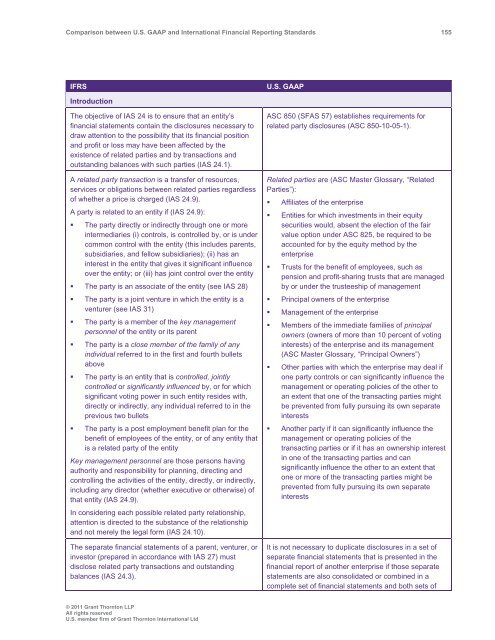Comparison between U.S. GAAP and International ... - Grant Thornton
Comparison between U.S. GAAP and International ... - Grant Thornton
Comparison between U.S. GAAP and International ... - Grant Thornton
You also want an ePaper? Increase the reach of your titles
YUMPU automatically turns print PDFs into web optimized ePapers that Google loves.
<strong>Comparison</strong> <strong>between</strong> U.S. <strong>GAAP</strong> <strong>and</strong> <strong>International</strong> Financial Reporting St<strong>and</strong>ards 155<br />
IFRS<br />
U.S. <strong>GAAP</strong><br />
Introduction<br />
The objective of IAS 24 is to ensure that an entity’s<br />
financial statements contain the disclosures necessary to<br />
draw attention to the possibility that its financial position<br />
<strong>and</strong> profit or loss may have been affected by the<br />
existence of related parties <strong>and</strong> by transactions <strong>and</strong><br />
outst<strong>and</strong>ing balances with such parties (IAS 24.1).<br />
A related party transaction is a transfer of resources,<br />
services or obligations <strong>between</strong> related parties regardless<br />
of whether a price is charged (IAS 24.9).<br />
A party is related to an entity if (IAS 24.9):<br />
• The party directly or indirectly through one or more<br />
intermediaries (i) controls, is controlled by, or is under<br />
common control with the entity (this includes parents,<br />
subsidiaries, <strong>and</strong> fellow subsidiaries); (ii) has an<br />
interest in the entity that gives it significant influence<br />
over the entity; or (iii) has joint control over the entity<br />
• The party is an associate of the entity (see IAS 28)<br />
• The party is a joint venture in which the entity is a<br />
venturer (see IAS 31)<br />
• The party is a member of the key management<br />
personnel of the entity or its parent<br />
• The party is a close member of the family of any<br />
individual referred to in the first <strong>and</strong> fourth bullets<br />
above<br />
• The party is an entity that is controlled, jointly<br />
controlled or significantly influenced by, or for which<br />
significant voting power in such entity resides with,<br />
directly or indirectly, any individual referred to in the<br />
previous two bullets<br />
• The party is a post employment benefit plan for the<br />
benefit of employees of the entity, or of any entity that<br />
is a related party of the entity<br />
Key management personnel are those persons having<br />
authority <strong>and</strong> responsibility for planning, directing <strong>and</strong><br />
controlling the activities of the entity, directly, or indirectly,<br />
including any director (whether executive or otherwise) of<br />
that entity (IAS 24.9).<br />
In considering each possible related party relationship,<br />
attention is directed to the substance of the relationship<br />
<strong>and</strong> not merely the legal form (IAS 24.10).<br />
The separate financial statements of a parent, venturer, or<br />
investor (prepared in accordance with IAS 27) must<br />
disclose related party transactions <strong>and</strong> outst<strong>and</strong>ing<br />
balances (IAS 24.3).<br />
ASC 850 (SFAS 57) establishes requirements for<br />
related party disclosures (ASC 850-10-05-1).<br />
Related parties are (ASC Master Glossary, “Related<br />
Parties”):<br />
• Affiliates of the enterprise<br />
• Entities for which investments in their equity<br />
securities would, absent the election of the fair<br />
value option under ASC 825, be required to be<br />
accounted for by the equity method by the<br />
enterprise<br />
• Trusts for the benefit of employees, such as<br />
pension <strong>and</strong> profit-sharing trusts that are managed<br />
by or under the trusteeship of management<br />
• Principal owners of the enterprise<br />
• Management of the enterprise<br />
• Members of the immediate families of principal<br />
owners (owners of more than 10 percent of voting<br />
interests) of the enterprise <strong>and</strong> its management<br />
(ASC Master Glossary, “Principal Owners”)<br />
• Other parties with which the enterprise may deal if<br />
one party controls or can significantly influence the<br />
management or operating policies of the other to<br />
an extent that one of the transacting parties might<br />
be prevented from fully pursuing its own separate<br />
interests<br />
• Another party if it can significantly influence the<br />
management or operating policies of the<br />
transacting parties or if it has an ownership interest<br />
in one of the transacting parties <strong>and</strong> can<br />
significantly influence the other to an extent that<br />
one or more of the transacting parties might be<br />
prevented from fully pursuing its own separate<br />
interests<br />
It is not necessary to duplicate disclosures in a set of<br />
separate financial statements that is presented in the<br />
financial report of another enterprise if those separate<br />
statements are also consolidated or combined in a<br />
complete set of financial statements <strong>and</strong> both sets of<br />
© 2011 <strong>Grant</strong> <strong>Thornton</strong> LLP<br />
All rights reserved<br />
U.S. member firm of <strong>Grant</strong> <strong>Thornton</strong> <strong>International</strong> Ltd
















